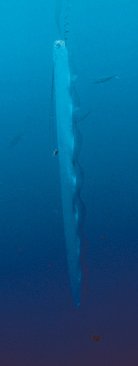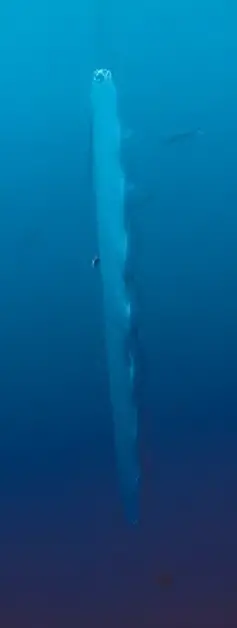Jonathan Bird had a weird experience when diving in the Bahamas last year. He saw this sort of elongated fish thing, with two long antennae, terminating in sort of fishing-lure things, coloured bright yellow.
The creature had a large plume on its head, and was propelled through the water in an upright position by an undulating fin that ran the length of its back. Coo-er!
Sorry, it wasn't a sea serpent this time, but a distinctly rare sighting of a decidedly rare creature: the oarfish (and that's it, opposite).
AS a professional underwater cinematographer, I spend a good deal of my time diving in different parts of the world and filming the creatures I find.
Generally, I shoot the things that sell – sharks, dolphins, whales and other large animals – but sometimes I encounter species that I have never seen or even heard about.

Rarely are they as unusual as my encounter with an oarfish.
In early May, 1996, I spent several days diving around New Providence in the Bahamas. On this particular assignment I was shooting still photos of silky sharks.
Silkies are known to frequent a dive site called the AUTEC (Atlantic Undersea Test and Evaluation Center) Buoy.
This is a buoy about 10m across anchored in about 2000m of water by the US Navy for use in submarine testing at the Tongue of the Ocean, off Nassau (described in the May 1997 issue of Diver).
When no subs are being tested, the Navy allows dive boats around the buoy. It is well known that large floating objects like buoys, logs or sargassum weed often attract large numbers of fish.
Nobody knows for sure why this happens, but it may be that small fish seek shelter from larger predators at these convenient rest stops, and the larger fish go there to hunt the smaller fish.
Some biologists suspect that they may just like the shade.
I jumped off the boat around noon and began a slow descent. When I reached about 12m I stopped and waited for the sharks to swim by, as the boat captain busied himself with chumming the water above.
Out of the corner of my eye I saw a shape ascending from the bottomless blue, about 20m away. My dive buddy, Brian, had also seen it and was swimming towards it. I joined in pursuit.
Finning as fast as I could, I kept an eye on the shape to determine what it might be. It was a species I did not recognise.
It had an extremely thin ribbon-like compressed body positioned vertically in the water with the anterior end pointing up.
It had two long antennae with what looked like yellow, diamond-shaped fishing lures on the ends and along the length of each.
The creature had a large plume of strands on its head pointing upwards and its body appeared silvery and reflective. Its dorsal fin ran the length of its back and undulated to propel it along.
It had no caudal fin as the body tapered to a point where the tail would normally be, and its large eyes immediately made me think that I was looking at a deep-sea creature.
My single photograph and Brian's two or three are the only ones we managed to get. When we got back to the dock and described the fish to the people at the dive shop, they thought we must be the victims of nitrogen narcosis.
They had never seen such a fish even though they had dived the site hundreds of times before.
I contacted Dr Milton Love, an ichthyologist at the University of California at Santa Barbara.
Working from a duplicate slide, he identified the fish as the oarfish (Regalecus glesne) noting, however, that the head appeared more blunt than in existing illustrations.
Just to be sure, he passed the image to another expert who confirmed the identification, astounded that we were probably the first divers ever to photograph this animal in its natural habitat.
The oarfish may be the creature that gave rise to the legends about “sea serpents”.

This long, skinny fish, with its strange-looking head covered in protrusions and reaching lengths perhaps as long as 15m, would certainly be more than enough to frighten the pants off a drunken sailor.
The first account of the fish was probably in 1771 when Danish naturalist Morton Brunnich made a note of a beast he found washed up on a beach in Norway.
The oarfish, named because of its long oar-like pelvic fins, was completely new to science.
The few examples of these fish that have appeared over the years have usually been found dead at the surface or washed up on a beach, so little is known about their lives or habits.
Several new pieces of scientific information were learned from our brief encounter. In observing a living animal we discovered that the fish swims with undulations of the dorsal fin only, not the entire body.
We also found that it seems to prefer a vertical orientation in the water column. The way it holds its pelvic fins was not known before, and its silvery coloration was different from that seen in the dead specimens.

